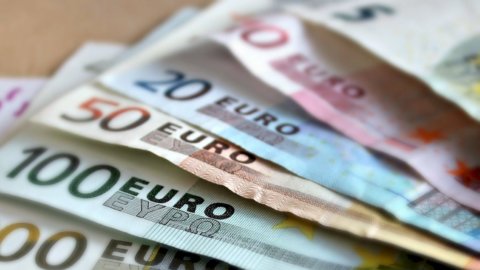In Italy the GDP is growing but so is inflation. If at first the data of the Italian economy revised upwards by Istat had rekindled hopes, the surge in inflation has extinguished all enthusiasm. After the slowdown in April, prices resumed their run in May reaching a level of 6,9% which had not been recorded since March 1986 (when it was at 7%). A figure that compares with 6% in the month of April and is higher than market expectations which indicated 6,2%.
As far as the Italian economy is concerned, Istat has sensibly revised the preliminary estimates communicated last month and in the first quarter of the year indicates a growth of 0,1% on a quarterly basis and 6,2% compared to the first quarter of 2021, explaining that "these are upward estimates compared to the preliminary estimate of last April 29, when the release showed a cyclical decrease of 0,2% and a trend increase of 5,8%". The cyclical revision of 0,3 percentage points, although significant - underlines the statistical institute - is not an absolute exception in this period still affected by the pandemic, given that in the first quarter of 2021 the upward revision had been 0,5, XNUMX points". Meanwhile, the news had given some oxygen to Business Square down compared to the start (from -0,32% down to -0,24% at 10.00), but inflation data has returned to slow down European price lists, and with them also Milan (-0,78% at 12.15).
Inflation at +6,9% per year: top since March 1986
According to preliminary estimates by Istat, this month the national consumer price index for the entire community - gross of tobacco - recorded an increase of 0,9% on a monthly basis and 6,9% on an annual basis ( from +6% of the previous month). A level not recorded since March 1986 (+7%).
The high increases in prices still contribute to triggering this inflationary spiral prices of energy goods (from +39,5% in April to +42,2% in May) and in particular unregulated energy (from +29,8% to +32,4), which according to the Statistical Institute has consequences for all other product sectors, whose increasingly high production costs impact on the final stage of marketing.
The consumer prices of almost all other types of product also accelerated, with the processed foods (from +5,0% to +6,8%) which raise the growth in prices by one percentage point shopping cart which rises to +6,7% from 5,8% (which has not happened since March 1986 when it was +7,2%). When accelerating also i prices of recreational services, culture and personal care (from +2,4% to +4,4%) and of transport related services (+5,1% to +6,0%).
Therefore, on an annual basis both the prices of goods (from +8,7% to +9,7%) and those of services (from +2,1% to +3,1%) accelerated. Finally, the institute highlights that the inflation acquired for 2022 is equal to +5,7% for the general index and +2,5% for the core component.
Italian GDP: recovery driven by domestic demand
“The recovery was determined above all by internal demand and in particular by investments against a negative contribution from foreign demand”, explains the Institute of Statistics, adding that “at the internal level, the contribution of private consumption was negative while both that of the public administrations and that of the change in stocks were zero. Hours worked and work units are also recovering well, against a slighter growth in per capita incomes and a stationary nature of job positions”.
Acquired growth for 2022 at +2,6%
As regards 2022, the growth acquired (i.e. the figure that would be achieved in the event of no cyclical change in the remaining quarters of the year), is equal to 2,6%. In the first quarter of the year the household spending on the economic territory he registered a quarter-on-quarter decline of 0,9%. In particular, purchases of durable goods grew by 2,7% and those of semi-durable goods by 2,4%. Conversely, consumption of non-durable goods decreased by 1% and that of services by 2%.
Furthermore, the statistical institute points out that the first quarter of 2022 had one working day less than the previous quarter and one more working day than the first quarter of 2021.
Compared to the previous quarter, and for the main aggregates of domestic demand, there was a 0,6% decrease in national final consumption, against a 3,9% increase in gross fixed investments. While, the cheap imports and exports they grew by 4,3% and 3,5% respectively.
France: GDP revised downwards (-0,2%) in the first quarter
Compared to the Italian one, hampers the French economy in the first quarter marking a -0,2%, doing worse than the preliminary estimate. The trend is no better, which marks a +4,5% compared to the 5,3% indicated in the first reading and the 4,9% of the previous quarter. This is what Insee communicates.
The slowdown of the French economy can be attributed to slowdown in consumer spending, which reported a decline of 1,5% after a 0,3% increase in the previous quarter. While domestic demand supported our economy, French demand had a negative impact (-0,6%). On the contrary, foreign demand had a positive impact of +0,2%.
Switzerland in recovery: GDP grows by 0,5% in the first quarter
Good news also for the Swiss economy which confirms its recovery (+0,5%) in the first quarter compared to the previous quarter, thanks to industry. On an annual basis, the change is +4,4%. In 2020, GDP fell by -2,4%, before rebounding by +3,8% in 2021. This was announced by the Secretariat of State for the Economy (Seco).
Driving the growth of the Swiss GDP is the manufacturing sector (+1,7%), above all thanks to industrial exports. The positive evolution of the industry has also partly involved the service sector, thus favoring the trend of wholesale trade and preventing a more robust drop in trade (-0,1%). Also the branch of the transport and communication (+0,2%) benefited from the increased transshipments of goods, while the reduced mobility due to the latest wave of the Coronavirus slowed significantly the hotel industry and Catering (-2,2%).





